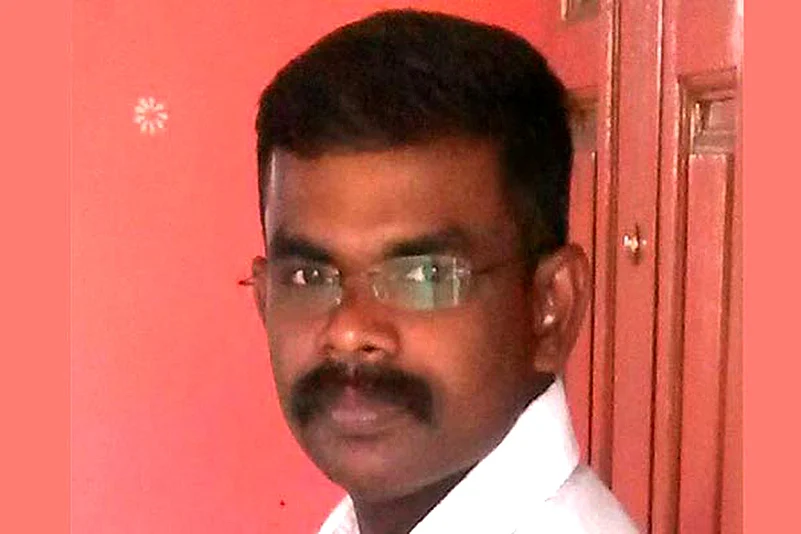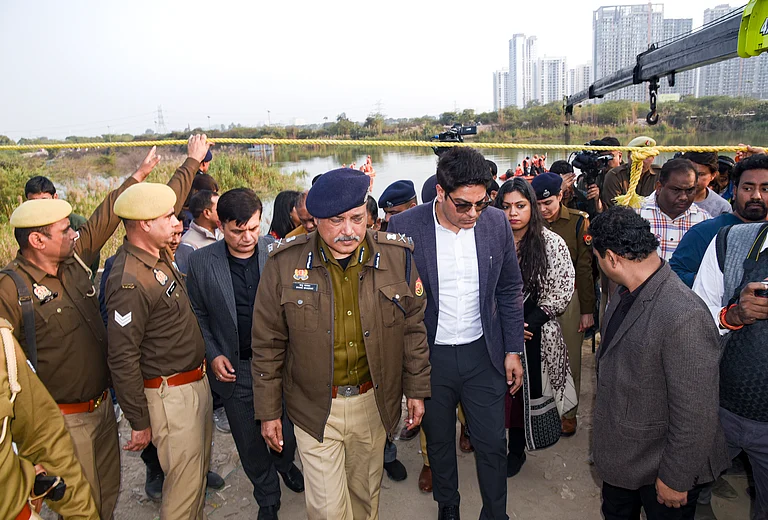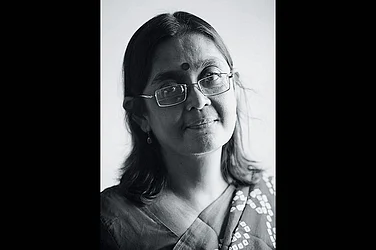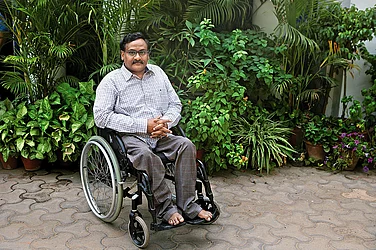The hounding of journalists is not new to Tamil Nadu. The governments of M. Karunanidhi and J. Jayalalitha have been active and prolific practitioners of this insidious exercise in their various terms in the past. So, the recent arrest of cartoonist Bala for his caricature of chief minister Edappadi Palanisami and two district officials came as little surprise. Following a complaint from the Tirunelveli district collector, Bala was booked for printing “defamatory material” and publishing it in electronic form. He was picked up from his Chennai home on November 5, and released the next day on bail.
The arrest invited widespread condemnation, but it has also been tempered by comments that Bala’s caricature was in poor taste. It showed the CM, district collector and police commissioner in the nude, covering their private parts with wads of currency as the charred body of a usury victim lay in the foreground. It was a critique of the inaction of the state administration to complaints of usury resulting in the self-immolation of a poor family asked to pay up mind-blowing interests on money they had borrowed.
“While I condemn his arrest I have to say that Bala’s cartoon is almost revolting,” wrote senior columnist T.N. Gopalan. “And it’s not just this one.” Bala had earlier invited the wrath of several women’s groups for alleged misogyny after one of his cartoons about DMK patriarch Karunanidhi and actor Kushboo. “It would have had the same effect if those three personalities had worn clothes,” observed cartoonist Mathi about Bala’s recent cartoon. “A cartoon should make you smile and not cringe.”

Bala’s arrest is yet another incident of the state government’s intolerance to a long list of other such attacks on freedom of expression in the past. In Tamil Nadu, editors have landed in jail, while others have been sought to be arrested using the assembly’s privilege powers. Dozens of defamation cases have been filed against various publications, most of them still pending before the courts.
The first stone was thrown by the DMK and its leader Karunanidhi in February 1971 when Thuglak, edited by Cho Ramaswamy, came under fire for publishing photographs of a Dravidar Kazhagam’s procession in Salem that had depicted Hindu gods Rama and Sita in the nude with a garland of slippers around their neck.

(From left) Rajagopal, S. Balasubramanian and B. Thirumavelan
Karunanidhi had initially denied that any such denigration had happened at Salem, but Thuglak countered his claim with photographic evidence. Even as the police came to the Ananda Vikatan press to seize the copies, bundles of the fortnightly were flung over the compound wall and found their way to the market, where they were sold at a premium. The irrepressible Cho published a cartoon in the next edition that showed Karunanidhi as the circulation-cum-advertising agent for Thuglak for having created a demand for his fledgling magazine.
“Actually, it was Karunanidhi who set the trend, hitting out at Cho and getting DMK cadres to vandalise theatres which screened Mohammed Bin Thuglak, a ripping satire on the venal and arrogant government,” recalls Gopalan.
Karunanidhi’s political rival, M.G. Ramachandran, proved no less intolerant when he was at the helm. His speaker P.H. Pandian, through an assembly ruling, jailed Ananda Vikatan editor S. Balasubramanian for publishing a cartoon that showed MLAs and ministers of the MGR government as thieves. After Balasubramanian, who had produced a few films with MGR as the lead, had spent a weekend in jail, the actor-leader “magnanimously” released him. MGR had even amended the law to make publication of ‘defamatory’ and ‘scurrilous’ articles cognisable and non-bailable offences. He had to later withdraw the diktat under the collective pressure of the media.
When Balasubramnian had challenged his arrest, a full bench of the Madras High Court awarded him Rs 1,000 “as a notional or token compensation by way of ‘monetary amends’ to the breach of the fundamental rights of the petitioner in vindication of his stand.” Balu, as he was known, framed the scanned copy of the cheque along with two 500-rupee notes and placed them in his office to show his victory on behalf of freedom of Press.
The misuse of the assembly and its breach of privilege powers were handy weapons of the even more intolerant Jayalalitha. In her first term (1991-96), the assembly sought to punish K.P. Sunil of the Illustrated Weekly of India for writing about certain seedy activities at the MLA hostel. Sunil went underground and managed to procure a Supreme Court stay. (Ironically, he went on to become a news editor of Jaya TV.)

J. Jayalalitha (left) and M. Karunanidhi
The next assault from the AIADMK-dominated assembly came in November 2003 during Jayalalitha’s second term when the house sentenced The Hindu’s N. Ravi (editor), Malini Parthasarathy (executive editor), R. Rangarajan (publisher), V. Jayanth (chief of bureau) and Radha Venkatesan (special correspondent) along with S. Selvam (editor of Murasoli) to 15 days imprisonment for breach of privilege.
Tipped off by Ananda Vikatan editor Balu, The Hindu’s editor-in-chief N. Ram sent his team into hiding before the house assembled on November 7 to pass the sentence. The Chennai police could not find the journalists at their office or their homes. When the city police had trouble finding Jayanth’s house, Jayalalitha herself pointed to the building as it was very close to her Poes Garden residence.
Expecting Ravi, Malini and Rangarjan to be present at The Hindu’s 125th anniversary function in Bangalore on November 8, a Chennai police team showed up at the venue, only to be further disappointed. “They even mistook my brother N. Murali for me and only when the Karnataka police vouched that it was him that they retreated,” chuckles N. Ravi. “Meanwhile the three of us—Ranga, Malini and I, were happily ensconced in a farmhouse in Karnataka.” Eventually, The Hindu team managed to get an SC stay after which the assembly rescinded the sentence. But Selvam, unable to get a stay, was let off only after a reprimand.
Later on, Karunanidhi and Jayalalitha’s favourite weapon of choice against the media was criminal defamation under Sections 499 and 500 of the IPC. Even here, Jayalalitha outdid her political rival by slapping more than a 100 cases against not just publications but also politicians who had criticised her. In Jayalalitha’s first term, she had in her individual capacity filed 120 defamation cases, but withdrew them before her term ended. From 2011, however, the cases were filed on behalf of the chief minister by the public prosecutor who would argue at each instance that it was the office of the CM that had been defamed.
This practice of delegating the defamation attack had been set by Karunanidhi, who between 2006 and 2011 had used the same public prosecutor’s office to file 52 defamation cases against publications and opponents. Jayalalitha merely followed the pattern and multiplied the numbers. Between 2011 and 2016, her government filed no less than 190 criminal defamation cases against the media and opponents.
“Jayalalitha not only slapped 212 cases against us during her three terms as CM but also cut off power supply to our office so we could not print our magazine,” recalls Nakeeran editor Rajagopal. “We had to smuggle out our layouts and had the magazine printed from the Murasoli press.” Rajagopal also says how publications were sued for merely reproducing critical statements of opposition leaders.
When actor Vijayakanth had challenged the slew of defamation cases against him, the Supreme Court had made this observation: “We find that most of these defamation cases are coming from Tamil Nadu. These criticisms are with reference to the conceptual governance of the state and not individualistic. Why should the state file a case for individuals? Defamation case is not meant for this. We will stay the proceedings.”
B. Thirumavelan, editor of political bi-weekly Junior Vikatan, points out how even genuine criticism on the performance of the government or unfulfilled promises were and are branded as defamatory. “The intent is to intimidate others from being critical rather than establish guilt. That is why none of the 20 cases against Ananda Vikatan and the 18 cases against me have been prosecuted beyond the first stage, even though we have not procured a court stay in any of them. After Jayalalithaa’s death no fresh cases have been filed,” says Thirumavelan.
What happens to these cases after Jayalalitha’s demise? “They will go on. The trial has already commenced in three cases and we have cross examined three witnesses. The cases were filed on behalf of the chief minister so they will continue since the office of the CM is still in vogue,” says prosecutor M.L. Jegan. The last has not been heard of Tamil Nadu’s war against the media.
By G.C. Shekhar in Chennai


























